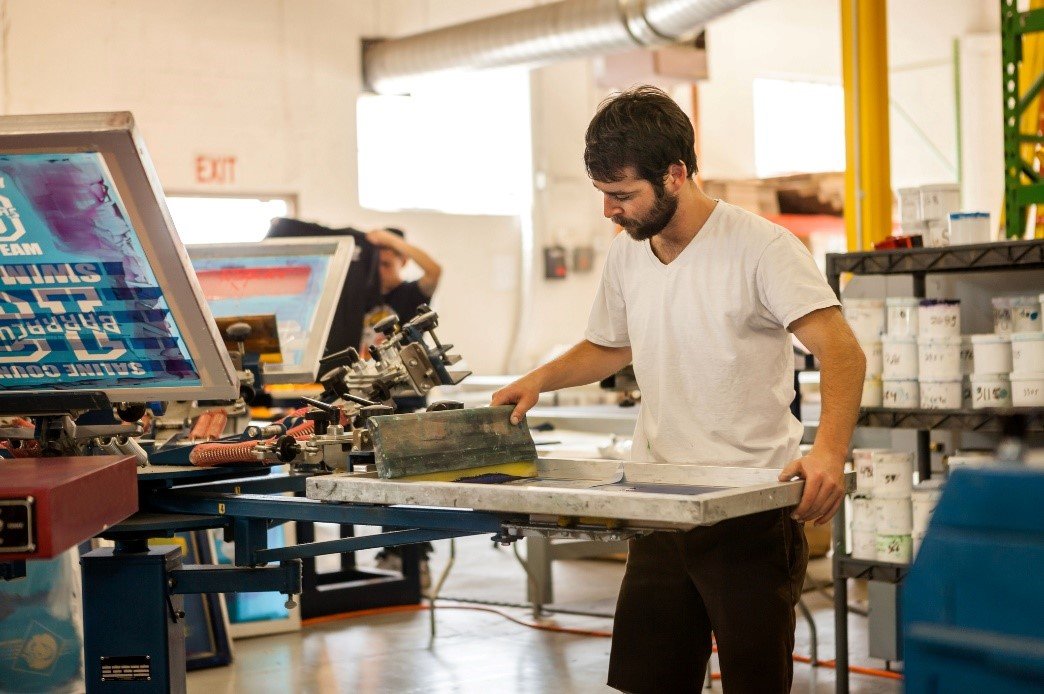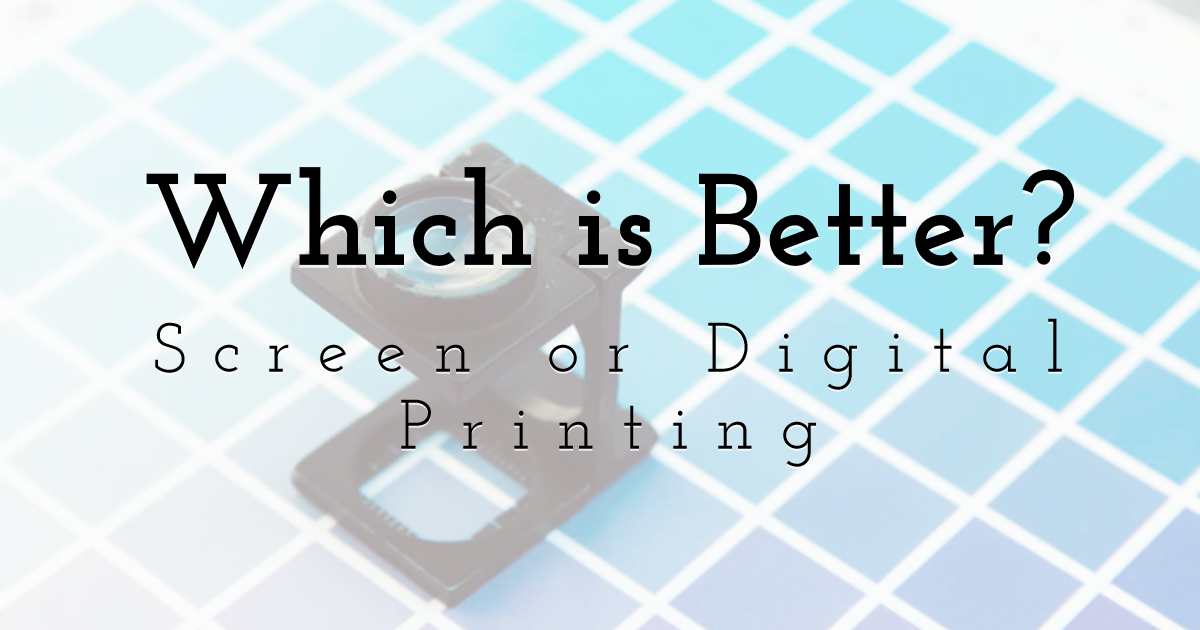An Unbiased View of Tx Tees
An Unbiased View of Tx Tees
Blog Article
Tx Tees Fundamentals Explained
Table of ContentsThe Greatest Guide To Tx TeesThe smart Trick of Tx Tees That Nobody is Talking AboutTx Tees - QuestionsThe 4-Minute Rule for Tx TeesSome Known Details About Tx Tees Indicators on Tx Tees You Need To KnowTx Tees Fundamentals Explained
That brings your overall to roughly $1,900 prior to tax obligation and delivery. Add up various other expenses, like the variety of energies it requires to run the store and the expense of ink and emulsion per layout. custom monograming. Take the print below. This is a one-color image, so the cost of ink per t shirt is around 20 cents.The solution needs to just be a couple of cents since you 'd just require to coat one screen for this work. Normally, printers attempt to make up to 45% revenue on a print task.

With DTF, you can publish a handful of t-shirts, or just one. Both display printing and DTF have their specific niches in the world.
The Of Tx Tees
The most effective method to understand? Ask about and see what printing shop like your own are doing. screen printing shop. Try both out and see which you like much better
When you're picking what kind of printing method to make use of for printing your art work styles on your garments, it is essential that you understand the differences between these 2 strategies so you can make best use of outcomes while lessening prices. Display printing is one of the most generally utilized method for printing designs on textiles.
DTG printing is also recognized as place or straight to garment printing due to the fact that it publishes just what is needed as opposed to making a screen as display printers do. https://disqus.com/by/txtees02/about/. Screen printing works by display filler squeegee screen printing ink display mesh screen, then transferring the photo to garment utilizing warmth and/or pressure
The DTG printer utilizes special dye-sublimation inks that are used into a pre-designed picture by an electronic printing system. The inks become component of the fabric, enabling for dynamic shades and phenomenal detail. It's additionally called spot or straight to garment printing due to the fact that it prints just what is needed rather than making a screen as screen printers do.
Little Known Facts About Tx Tees.
Initially, it's much faster - you can print a fullcolor image in mins, in contrast to hours for display printing. Second, there's no established up time or expenses included - you can publish any style you like, without having to create a screen. Third, there's no waste - due to the fact that display printers screen print one layout each time, they need to evaluate each shade individually.
The paper is extremely costly and can only be utilized when. Once it's published on, it has actually to be thrown out. - The preliminary acquisition cost is less than the ahead of time financial investment of DTG printers- You can print multi-color designs one screen at once as opposed to needing to publish each shade individually like DTG printing.

Getting The Tx Tees To Work
Nevertheless, rather than utilizing display mesh as screen printers do, dye sublimation printers make use of laser technology to move your pictures onto garments or paper. A warmth process transfers the color from its solid-state straight right into the gas stage which in turn integrates it onto material substratums when they are rapidly heated up to high temperature levels under high stress.
Sublimation printing is environment-friendly. It makes use of less water than screenprinting, and since it doesn't include the usage of hazardous solvents, it's risk-free for all kinds of garments. The color sublimation inks are additionally odor-free when cured, unlike screen printers that use hazardous chemicals throughout the screen printing process that leave behind an unpleasant odor.
They likewise conserve money on expensive devices like exposure units considering that dye sublimation printers don't need a UV exposure system or a flash remedy oven that is normally utilized in screen printing (custom screen printing). What is straight to garment printing (DTG Printing)? DTG printing is an electronic screenprinting process that prints directly onto material using specialized inkjet printers
Tx Tees - Truths
DTG printing uses numerous advantages over typical screenprinting, including the ability to publish photographic top quality pictures, greater shade vibrancy, and the capability to publish styles on darker fabrics. DTG printers function by warming the textile ink till it transforms right into a gas. The gas then penetrates the material, bonding with the fibers to create an irreversible print.

Display printers just prepare their screen then start publishing till they lack item or ink.- There is a large variety of seasoned display printers around the world, which can be valuable for novices. - It's a slower process - display printers usually need to wait on the ink to dry prior to they can print the following shade- Screen printers require manual work, so there's a greater learning curve and it takes longer to create a high-grade layout- Screen printing isn't as accurate as DTG printing, so you may obtain some "blood loss" of colors from one component of the picture onto one more if not done properly.
Our Tx Tees Diaries
Nevertheless, rather than making use of screen mesh as display printers do, dye sublimation printers use laser innovation to transfer your pictures onto garments or paper. A warmth process moves the color from its solid-state directly right into the gas stage which consequently integrates it onto fabric substratums when they are swiftly heated to heats under high stress.
Sublimation printing is environmentally friendly. It makes use of less water than screenprinting, and due to the fact that it doesn't include making use of dangerous solvents, it's risk-free for all sorts of apparel. The dye sublimation inks are likewise odor free when healed, unlike screen printers that utilize unsafe chemicals during the screen printing process that leave an undesirable odor.
They also save cash on costly equipment like exposure systems given that color sublimation printers don't require a UV direct exposure device or a flash treatment stove that is generally utilized in display printing. What is direct to garment printing (DTG Printing)? DTG printing is a digital screenprinting process that prints directly onto fabric utilizing specialized inkjet printers.
A Biased View of Tx Tees
DTG printing uses lots of benefits over conventional screenprinting, including the ability to publish photo high quality photos, better shade vibrancy, and the capability to print designs on darker textiles. DTG printers function by heating up the textile ink until it develops into a gas. The gas then penetrates the textile, bonding with the fibers to produce a permanent print.
Report this page